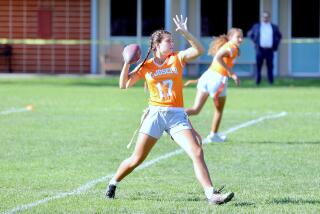RISE AND SHINE : Oshiro Is Making Most of Opportunity to Play No. 1 Singles for Loyola Marymount
- Share via
Like any college freshman, Julie Oshiro had to get adjusted to college life at Loyola Marymount.
There were all those parties during orientation week. It took one semester for Oshiro to find out that she was not cut out to be a drama major. Dorm life also has been eye-opening--for a while now her diet has consisted of Domino’s pizza with mushrooms, olives and bell peppers.
Then there’s the tennis team: Another fast start. Another big change.
The 5-foot-3 Oshiro began the season as the Lions’ No. 3 singles player. She promptly won her first seven matches, including a season-opening Class C Title at the Sun Bowl Invitational in El Paso. Her fast start, combined with a back injury to the Lions’ top player, Lyn Stoner, soon led to Oshiro, a freshman, playing No. 1 singles.
In her first two matches as the top-seeded player, Oshiro was overwhelmed. During a one-week span, Pepperdine’s Noelle Porter shut her out, 6-0, 6-0, and USC’s Tricia Laux, beat her, 6-1, 6-2. At this point, LMU had a losing record (4-5).
“When I turned No. 1, it was a big adjustment,” said Oshiro, who won the 1990 L.A. City championship as a senior at Gardena High. “It just hit me. As soon as I turned No. 1, I lost my first two matches. It just hit me more that I needed to get the mental side of my game into it. It is mentally a much bigger deal than physically.”
From that point on, Oshiro has brought her game up a notch. She has won 10 of her past 14 matches at No. 1 singles (she also plays doubles) and is 21-6 on the year overall.
Since Oshiro became the Lions’ top-seeded player, LMU has the same record as its most fabulous freshman (10-6). The Lions are 14-9 overall. They play Santa Barbara today at Loyola Marymount..
“The transition that occurred was that we started her on a lower level (third seed) as a freshman because we wanted her to get a feel for the competition level,” said Jamie Sanchez, who coaches LMU’s men’s and women’s teams. “Her immediate numbers are a little misleading. Even though she won a lot of matches, each of her first two matches went into tiebreakers.
“The wins got her going and got her more of a feel for the competition at this level. Then we brought her up (to No. 1 singles). She brought the success with her.”
Oshiro has been playing since she was age 7 and relies mostly on a baseline game in her matches, although she can volley well and ended a practice earlier in the week by smacking five consecutive two-fisted backhand volleys for winners during a doubles’ workout.
Talk to the people around her, and they rave about her talent.
“I was No. 1 at the beginning of the year and asked Jamie (Sanchez) about her,” sophomore Kim Florez said. “I asked why she was not No. 1, because she was beating me. It’s tough to play her because she’s so mentally tough. She just picks balls out of the air for winners. If you hit a normal shot, she might just return it normally. But if you hit a great shot at her, her next shot will be even better. It’s just tough to play her.”
Said Sanchez: “My assessment of what makes her so good, is that it is a combination of things. She combines a high level of physical ability with a very mentally tough outlook on the game. She never gives up and is always trying to make things happen. She’s not one of those players who waits for things to happen and waits for opponents to make an error . . . She also has mental tenacity. She’s very tough. She can get behind and stays very determined.”
By no means does this mean the freshman is a finished product.
“I have a lot to learn,” Oshiro said. “This is just my first year. When I’m not playing well, I need to learn to get into a rhythm and groove and not just play the same way. I need to learn to play at the net more.”
Sanchez said: “In most of her losses, the big thing has been experience. At times in her matches, her inexperience shows. In college tennis, when you are the No. 1 seed, you are playing the best. The No. 1 player usually is the most experienced. We have a team that’s 90% freshmen and sophomores.
“Julie has a lot to find out on the court. So far, she’s done very well and maintained very positive momentum. . . . One thing we are working on with her is to do things with more variety. At the college level every match is not only talent against talent, there is also the pressure of how strategic you are. You cannot rely on the same strategy over and over. It is a little higher intellectual level of play. That’s why we are working on her having variety to her game.”
Because seven of the nine women on the team are underclassmen, there have not been any problems concerning a young player coming in and taking over. After all, all the players are young.
“I love this team,” Oshiro said. “The people are neat. We are always trying to have fun and laughing. We all get along so well. A lot of other teams notice it and talk to us about it.”
This helps, because tennis is not the highest priority on the Loyola Marymount athletic department’s list. The women’s team receives two and three-fourths scholarships (Oshiro receives partial aid) in a sport where the NCAA allows a maximum of eight.
“We are at a . . . certain level,” Sanchez said. “Our budget reflects our being able to recruit at that level. It’s been difficult. But when you have money limitations, you try to get the most out of the talent you have. I feel we have been competitive. Maybe Julie will help get us to the next level.”
More to Read
Go beyond the scoreboard
Get the latest on L.A.'s teams in the daily Sports Report newsletter.
You may occasionally receive promotional content from the Los Angeles Times.










